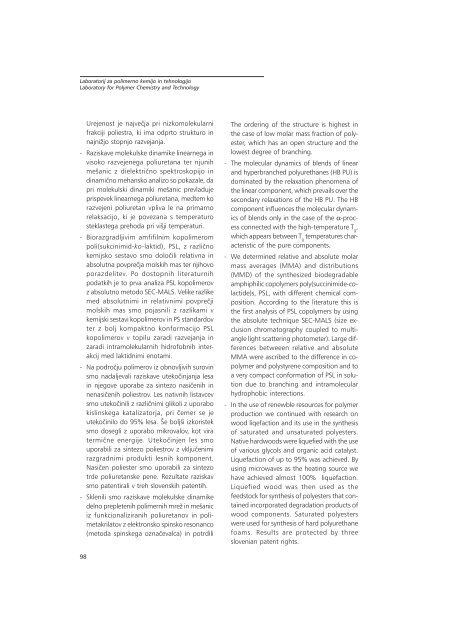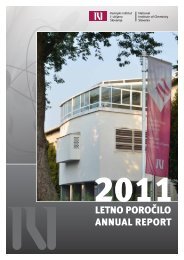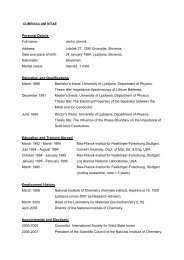Letno poročilo 2005
Letno poročilo 2005
Letno poročilo 2005
Create successful ePaper yourself
Turn your PDF publications into a flip-book with our unique Google optimized e-Paper software.
Laboratorij za polimerno kemijo in tehnologijo<br />
Laboratory for Polymer Chemistry and Technology<br />
Urejenost je najve~ja pri nizkomolekularni<br />
frakciji poliestra, ki ima odprto strukturo in<br />
najni`jo stopnjo razvejanja.<br />
- Raziskave molekulske dinamike linearnega in<br />
visoko razvejenega poliuretana ter njunih<br />
me{anic z dielektri~no spektroskopijo in<br />
dinami~no mehansko analizo so pokazale, da<br />
pri molekulski dinamiki me{anic prevladuje<br />
prispevek linearnega poliuretana, medtem ko<br />
razvejeni poliuretan vpliva le na primarno<br />
relaksacijo, ki je povezana s temperaturo<br />
steklastega prehoda pri vi{ji temperaturi.<br />
- Biorazgradljivim amfifilnim kopolimerom<br />
poli(sukcinimid-ko-laktid), PSL, z razli~no<br />
kemijsko sestavo smo dolo~ili relativna in<br />
absolutna povpre~ja molskih mas ter njihovo<br />
porazdelitev. Po dostopnih literaturnih<br />
podatkih je to prva analiza PSL kopolimerov<br />
z absolutno metodo SEC-MALS. Velike razlike<br />
med absolutnimi in relativnimi povpre~ji<br />
molskih mas smo pojasnili z razlikami v<br />
kemijski sestavi kopolimerov in PS standardov<br />
ter z bolj kompaktno konformacijo PSL<br />
kopolimerov v topilu zaradi razvejanja in<br />
zaradi intramolekularnih hidrofobnih interakcij<br />
med laktidnimi enotami.<br />
- Na podro~ju polimerov iz obnovljivih surovin<br />
smo nadaljevali raziskave uteko~injanja lesa<br />
in njegove uporabe za sintezo nasi~enih in<br />
nenasi~enih poliestrov. Les nativnih listavcev<br />
smo uteko~inili z razli~nimi glikoli z uporabo<br />
kislinskega katalizatorja, pri ~emer se je<br />
uteko~inilo do 95% lesa. [e bolj{i izkoristek<br />
smo dosegli z uporabo mikrovalov, kot vira<br />
termi~ne energije. Uteko~injen les smo<br />
uporabili za sintezo poliestrov z vklju~enimi<br />
razgradnimi produkti lesnih komponent.<br />
Nasi~en poliester smo uporabili za sintezo<br />
trde poliuretanske pene. Rezultate raziskav<br />
smo patentirali v treh slovenskih patentih.<br />
- Sklenili smo raziskave molekulske dinamike<br />
delno prepletenih polimernih mre` in me{anic<br />
iz funkcionaliziranih poliuretanov in polimetakrilatov<br />
z elektronsko spinsko resonanco<br />
(metoda spinskega ozna~evalca) in potrdili<br />
98<br />
The ordering of the structure is highest in<br />
the case of low molar mass fraction of polyester,<br />
which has an open structure and the<br />
lowest degree of branching.<br />
- The molecular dynamics of blends of linear<br />
and hyperbranched polyurethanes (HB PU) is<br />
dominated by the relaxation phenomena of<br />
the linear component, which prevails over the<br />
secondary relaxations of the HB PU. The HB<br />
component influences the molecular dynamics<br />
of blends only in the case of the α-process<br />
connected with the high-temperature T g ,<br />
which appears between T g temperatures characteristic<br />
of the pure components.<br />
- We determined relative and absolute molar<br />
mass averages (MMA) and distributions<br />
(MMD) of the synthesized biodegradable<br />
amphiphilic copolymers poly(succinimide-colactide)s,<br />
PSL, with different chemical composition.<br />
According to the literature this is<br />
the first analysis of PSL copolymers by using<br />
the absolute technique SEC-MALS (size exclusion<br />
chromatography coupled to multiangle<br />
light scattering photometer). Large differences<br />
betweeen relative and absolute<br />
MMA were ascribed to the difference in copolymer<br />
and polystyrene composition and to<br />
a very compact conformation of PSL in solution<br />
due to branching and intramolecular<br />
hydrophobic interections.<br />
- In the use of renewble resources for polymer<br />
production we continued with research on<br />
wood liqefaction and its use in the synthesis<br />
of saturated and unsaturated polyesters.<br />
Native hardwoods were liquefied with the use<br />
of various glycols and organic acid catalyst.<br />
Liquefaction of up to 95% was achieved. By<br />
using microwaves as the heating source we<br />
have achieved almost 100% liquefaction.<br />
Liquefied wood was then used as the<br />
feedstock for synthesis of polyesters that contained<br />
incorporated degradation products of<br />
wood components. Saturated polyesters<br />
were used for synthesis of hard polyurethane<br />
foams. Results are protected by three<br />
slovenian patent rights.







